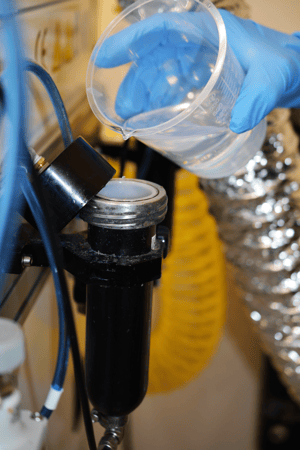 You have completed your search for an ideal conformal coating chemistry, one that will provide your PCBs the protection and reliability demanded by your industry and customers. After all that work, you probably assume your job is finished. Our apologies for being the bearer of bad news: There is still work to be done. In this basic presentation and discussion, we will talk about the proper choice and implementation of thinners for your coating. In many cases, a mistake in thinner can harm or even completely negate the protective properties of your conformal coating when applied to your PCB.
You have completed your search for an ideal conformal coating chemistry, one that will provide your PCBs the protection and reliability demanded by your industry and customers. After all that work, you probably assume your job is finished. Our apologies for being the bearer of bad news: There is still work to be done. In this basic presentation and discussion, we will talk about the proper choice and implementation of thinners for your coating. In many cases, a mistake in thinner can harm or even completely negate the protective properties of your conformal coating when applied to your PCB.
What is a thinner? Is it different from a stripper?
Thinners vs. strippers. Sounds like an episode of “Survivor,” but in our world, this odd wording choice is often spoken and actually makes sense. We believe the following homemade definitions are appropriately related to the use of thinners and strippers with PCBs and conformal coatings.
Thinners and strippers are two different things.

Thinner: Any liquid mixed with a conformal coating for the purpose of lowering the viscosity and/or solids content of the coating for ease of application or other processing issues.
Stripper: Any liquid used to dissolve, remove, and “strip” away dried conformal coating from a PCB or component, allowing for removal or rework.
Thinners and strippers are always liquids. They range from the extremely mild and simple, including alcohols and even just water, to aggressive blends of industrial solvents such as MEK, toluene, and xylene. We will be limiting our discussion primarily to thinners here, but it is important to note that they are rarely the same material.
As defined by their function, a stripper liquid is typically a much more aggressive solvent with strong chemical removal properties as it is used to remove dried and cured coatings. As a result, it is rarely appropriate to use a stripper chemical in place of a thinner. The aggressive chemical and solvent action of many strippers can lead to damage to containers, liners, feed lines, seals and other areas of your application equipment.
A thinner, on the other hand, is often a much milder liquid or solvent carefully designed to be compatible with your conformal coating as well as with all parts of standard application equipment. Since it is intended to be compatible with and easy on your coating and parts, it is most likely not aggressive enough to be used for stripping purposes.
To conclude this section, let us finish with a few simple statements:
- Do not use your thinners as strippers, and do not use your strippers as thinners.
- Not all conformal coatings can utilize thinners. Examples include most silicone and UV materials.
What are the main functions of thinners?
As we have already discussed, the one and only function of a thinner is to lower the viscosity and/or solids percentage of your conformal coating.
But why do I want to do that?
There are a huge number of processing reasons why thinning of a conformal coating is necessary and of benefit. Here are a few:
- It leads to the appropriate viscosity for the application method.
- atomized spray application
- film/curtain/fan-coating application
- brush-on application
- dip application
Note: Details and specific viscosities vary and will be discussed in future postings.


Image 1: Spray Coating Image 2: Film Coating
- It improves drying characteristics to avoid surface defects, such as
- entrapped bubbles,
- uneven surfaces (“orange peel,” for example), and
- “spider-webbing” (see video)
These are just a few of the potential uses for thinners. There are many more that can be very specific to your process and PCB design.
Do I really need to use thinners? What can go wrong?
If you are using a UV curable or silicone conformal coating, the short answer to this question is no, you do not need to use thinners. HumiSeal products in these chemistries are supplied at specific viscosities, and thinning is not possible or appropriate.
Based on the functions of thinners discussed above, here is a short list of the most common defects and failures possible when thinners are used ineffectively:
- surface “skinning”
- entrapped bubbles
- orange peel or other surface defects
- slow or inadequate drying or curing
- spraying difficulties
- “spider-webbing” effect
- poor edge definition of spray pattern, overspray
- excessive coating wicking underneath components
- inconsistent coating thickness due to excessive or inadequate surface flow
- flow-through board holes
Any of the above defects in your finished conformal coating has the potential to lower and even completely negate the protective characteristics of your coating. Surface defects, bubbles, and excessive coating flow can lead to bridging of lead gaps and issues such as cracking, causing possible electrical failures.
In conclusion, the effective and proper use of thinners can be just as important to PCB reliability over time as the initial choice of the coating itself.
As a supplier of electronics protection polymers and coatings, Chase Corporation and its employees can help you with an unbiased approach to evaluating your application and process. We’ll show you how to maximize efficiency, minimize cost, and improve product reliability. Our outstanding manufacturing and technical support groups can provide your organization with a reliable global supply, unmatched quality, and superior technical support.







